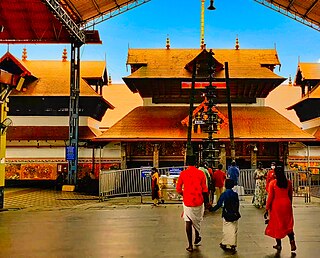
GuruvayurIPA:[guɾuʋɐːjuːr]) is a municipal temple town in Thrissur district, of Kerala State in India. It is a suburban town of Thrissur city, located 27 kilometres (17 mi) from Thrissur towards the north-west. It houses the Guruvayur Shri Krishna Temple. It is located at a distance of 292 km (181 mi) from the state capital Trivandrum towards the north-west, 80 km (50 mi) from Kochi towards the north, 90 km (56 mi) from Calicut towards south.
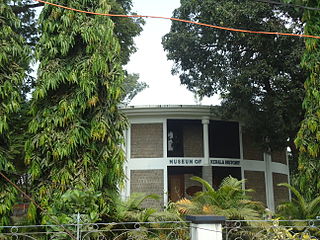
Edappally is a ward of Kochi, Kerala. The name is also used to refer to adjacent wards of Kalamassery and Thrikkakkara municipalities. Edappally is a major commercial centre as well as a prominent residential region. Edappally junction is one of the busiest junctions in the city.

Mammiyur Mahadeva Temple is a popular Shiva temple situated in Guruvayoor, Thrissur district of Kerala, India. Every devotee who goes to Guruvayur Temple is supposed to go to Mammiyoor also, as the ritual goes. Only Hindus are allowed inside the temple premises. The temple is a part of the 108 famous Shiva temples in Kerala and one among the five Shiva temples around Guruvayoor. The main deity is Lord Shiva, who is installed in the concept of 'Uma Maheshwara' - His form with Goddess Parvathi on his left. There is a shrine for Lord Vishnu also here. The sub-deities are Lord Ganapathi, Lord Subrahmanya, Lord Ayyappan, Goddess Kali and Serpent deities. This temple is managed by Malabar Devaswom Board. Daily three poojas are conducted. Puzhakkara Chennas Mana is the hereditary Thanthri of this temple too. Shivaratri and Ashtami Rohini are the major festivals.

Alathiyur Hanuman Temple, also known as Alathiyur Perumthrikkovil or Hanuman Kavu is a famous Hindu temple located between the Ponnani River and the Bharathappuzha at Alathiyur near Tirur, Malappuram district, Kerala state, India. Although the main deity is Rama, the seventh avatar of Vishnu, Hanuman, believed to be an incarnation of Shiva and a devotee of Rama and a Chiranjivi, is as famous as the main deity in the temple. Also reside in the temple as sub-deities of equal importance: Lakshmana, Ganesha, Maha Vishnu, Durga, Bhadrakali, Ayyappan, and Naga deities. According to legend, the idol of Hanuman was consecrated 3000 years ago by Sage Vasishtha, one of the Saptarishis. Over the years, the custodians of the temple were the Alathiyur village Nambudiri Clan, the King of Vettathunad, and the Samuthiri of Kozhikode. Aval is the main offering in this temple. The main annual event here is the festival held on the days corresponding with the Stars of Pooradam, Uthradam and Thiruvonam in the month of Thulam corresponding to mid-October to mid-November. The month of Karkidakam, corresponding to mid-July and mid-August, popularly called the Ramayana month, is usually crowded. The weekdays of Tuesday, Thursday and Saturday are also important as they are considered auspicious for Hanuman. The temple is administered by a Trust under the Malabar Devaswom Board, with the Samuthiri royalty as the Chief Trustee. This is believed to be the most important temple among the temples under the administration of the Malabar Devaswom Board.

Chavakkad, formerly Chowghat, is a municipality in the Thrissur district of the Indian state of Kerala. Chavakkad is noted for its beach and fishing. It lies on National Highway 66 is located about 75 km (47 mi) north of the city of Kochi, 25 km (16 mi) northwest of Thrissur, and 24 km (15 mi) south of Ponnani.
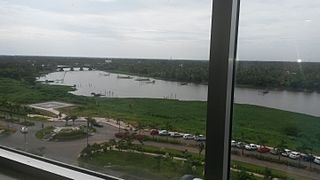
Cheranallur or Cheranellore or Cheranelloor is a suburb of Kochi city in the state of Kerala, India and lies on the banks of the Periyar River. According to tradition, the area was named by its earlier inhabitants who found this place very fertile and beautiful. The name in its local language Malayalam means "Good Village of Cheras".
Ernakulam refers to the western part of the mainland of Kochi city in Kerala, India. Ernakulam is the most urbanised part of Kochi and has lent its name to Ernakulam District.

The Aranmula Parthasarathy Temple is a Hindu temple located near Aranmula, a village in Pathanamthitta District, Kerala, South India. It is dedicated to the Lord Krishna, an avatar of Vishnu, who is worshipped as Parthasarathy. Constructed in the Kerala style of architecture, it is one of the "Divya Desams", the 108 temples of Vishnu revered by the Alvar saints.

The Vilwadrinatha Temple is a Hindu temple in Thiruvilwamala, a town in the city of Thrissur, Kerala, India. The principal deities are Rama, the seventh incarnation of the god Vishnu, and his brother, Lakshmana. It figures among the Abhimana Kshetrams in Vaishnavite traditions. This is one of the four major Rama temples in Kerala — the other three are in Thriprayar, Kadavallur, and Thiruvangad. The temple houses an idol of Lakshmana, which is rare in India. Vilwadrinatha Temple is located in the centre of the community of Thiruvilwamala, atop a 100-foot-high hillock. Visible from the temple is Bharathappuzha, the second-largest river in Kerala, which flows past the temple's northern side from around 3 kilometres away.

Punkunnam Shiva Temple is a small temple dedicated to the Hindu god Shiva, located in Punkunnam, a suburb of Thrissur city in Kerala. There are shrines to Parvati, Ganapathi, Ayyappan, Krishna as Parthasarathy and Nāgas. It is administered by Cochin Devaswom Board.

Madayikavu (Māḍāyik्kavu), also known as Thiruvarkadu Bhagavathi Temple, is a significant ancient Kaula Shakti shrine in Kerala, located near Pazhayangadi, Kannur. With a distinguished history spanning over two millennia, the Kavu was administered by various regional dynasties. The Bhagavathi was revered by these dynasties as their royal family deity, and they also carried out renovations of the Kavu at multiple junctures throughout history.
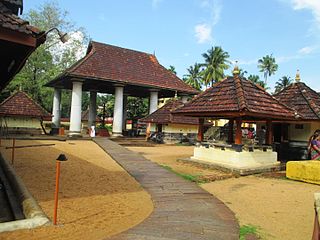
ThiruvanchikulamSivaTemple is a Hindu temple situated in Kodungallur in Thrissur district of Kerala state, India. Constructed in the Kerala style of architecture, the temple is believed to have been built during the Chera period. Shiva is worshipped as Mahadeva and his consort Parvathi as Umadevi. There are 33 sub-deities in this temple, the highest number so in Kerala.
Ivor Madom Parthasarathy Temple is a popular temple situated in Pampady village near Thiruvilwamala in Thrissur district, on the southern bank of Bharathappuzha, the second longest river of Kerala. The main deity of this temple is Lord Krishna as Parthasarathy, and there are sub-shrines for Ganapathi, Ayyappan, Shiva and Snake deities. The riverside near this temple is famous for performing rituals for dead ancestors. There is also a crematorium, jointly owned by Ivor Madom trust and Thiruvilwamala Grama Panchayat, near this temple.
There are places of worship considered important in the Kannur district. Kannur District is one of the 14 districts in the state of Kerala, India. The town of Kannur is the district headquarters, and gives the district its name.
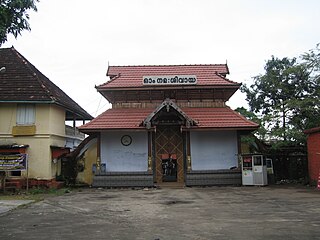
Ernakulam Shiva Temple, also known as Ernakulathappan Temple, is one of the major temples of Kerala, located in heart of Ernakulam, Kochi,Kerala, India. The temple, dedicated to Lord Shiva, is considered as the city temple, with the presiding deity as the protector of the city, as per local Hindu faiths and traditions. As per the common practice in Kerala, the deity is reverently called Ernakulathappan, which means Lord of Ernakulam. The temple is located within the Durbar Hall Ground. The temple history itself has deep association with history of the city and was one of the 7 royal temples of Kochi Maharajas. The temple is now under administration of Cochin Devaswam Board. The temple in its current form was built under active patronage of Diwan Sri Edakkunni Sankara Warrier in year 1846 and raised it level of a Royal temple in the Kochi Kingdom. The temple is built on 1-acre (4,000 m2) land. The temple is one of the major Shiva temples in Kerala counted along with the Ettumanoor Mahadevar Temple, Kaduthruthy Mahadeva Temple, Vaikom Temple, Chengannur Mahadeva Temple, Vadakkunathan temple, and Sreekanteswaram Mahadeva Temple, Thiruvananthapuram.

Thirumoozhikulam Sree Lakshmanaperumal Temple is located in Thirumoozhikalam (Moozhikkulam) in Ernakulam district of Kerala, India. The temple finds mention in some of verses of ancient Tamil Vedam sung by the Sri Vaishnava Alvars, particularly Nammalvar and Tirumangai Alvar and classified as Divya Desams, the 108 holy temples revered in the canon. This belongs to one of the 13 Malai Naatu (Kerala/Chera) Divya Desams, the Divya Desams located in Kerala.

The Thripuliyoor Mahavishnu Temple is a Hindu temple dedicated to Vishnu and located in Puliyoor, Alappuzha District, Kerala, South India. Constructed in the Kerala style of architecture, the temple is glorified in the Nalayira Divya Prabandham, the early medieval Tamil canon of the Alvar saints from the 6th–9th centuries CE. It is one of the 108 Divya Desams dedicated to Vishnu, who is worshipped as Mayapiran/Thripuliyoorappan. The nearest railway station to the temple is located at Chengannur, while the nearest airport is Trivandrum International airport.
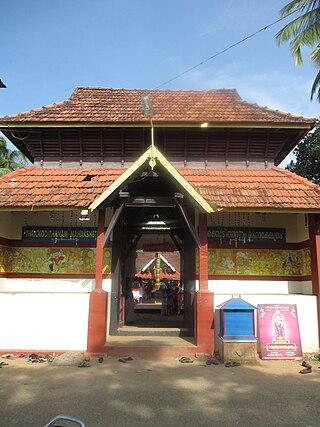
Thrikodithanam Mahavishnu Temple is a Hindu temple dedicated to Vishnu and located in Thrikkodithanam, Kottayam District, Kerala, South India. Constructed in the Kerala style of architecture, the temple is glorified in the Nalayira Divya Prabandham, the early medieval Tamil canon of the Alvar saints from the 6th–9th centuries CE. It is one of the 108 Divya Desam dedicated to Krishna, an avatar of Vishnu, who is worshipped as Mahavishnu. The nearest railway station to the temple is located in Changanassery, while the nearest airport is Cochin International Airport.

Cochin Tirumala Devaswom, also called Gosripuram is the biggest and most important socio-religious institution of Gowda Saraswat Brahmins of Kerala, India. The temple is situated at Cherlai in the heart of Mattancherry town in Cochin area which is one of the earliest settlements of GSBs in Kerala. The temple was established in the later half of the 16th century. The history of GSBs in Kerala is inter-woven with that of this temple and its Venkateswara idol.
Karuvathoor Sree Ramaswamy Temple is a Hindu temple located at Kurumaldesam in the Velur panchayat of Thrissur district in the state of Kerala, India. This temple is located close to the Kurumal Sree Bhagawati Temple. Both temples function under the Cochin Devaswom Board. Karuvathur temple is about 3 km from the Vengilassery Manimalarkavu temple where the Maru Marakkal Struggle took place and also Kumbha Bharani - Kuthira Vela is celebrated and the Kururamma Temple associated with the story of Lord Krishna. Renovation work is underway at the Karuvathoor temple.
















